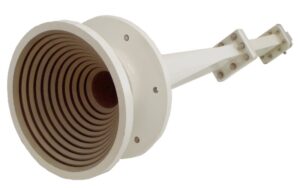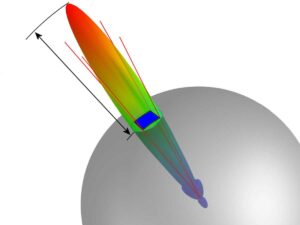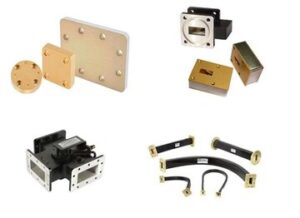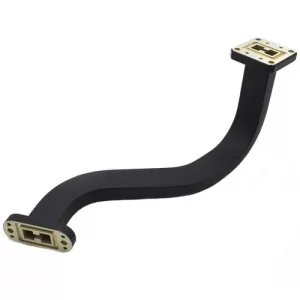Table of Contents
How an Antenna Feedhorn Works: Basic Design
An antenna feedhorn is a specialized waveguide component that directs electromagnetic waves between the antenna and the transceiver. It plays a critical role in minimizing signal loss—typically below 0.5 dB—while optimizing frequency focus. Most feedhorns operate in the GHz range, making them essential for high-frequency applications like satellite dishes and radar.
The feedhorn’s design ensures efficient signal transfer by matching the antenna’s focal point to the waveguide or low-noise block (LNB). A well-designed feedhorn reduces side lobes (unwanted signal radiation) by up to 20 dB, improving overall system performance. Common materials include aluminum (for lightweight durability) and copper-plated steel (for enhanced conductivity).
| Key Parameter | Typical Value | Impact on Performance |
|---|---|---|
| Frequency Range | 4–50 GHz | Determines application suitability |
| Signal Loss | <0.5 dB | Affects reception clarity |
| Side Lobe Suppression | 15–20 dB | Reduces interference |
Feedhorns often feature corrugated or smooth walls, with corrugated designs reducing wave reflections for better efficiency. In satellite dishes, the feedhorn’s flare angle (usually 10°–60°) ensures optimal signal capture. Understanding these fundamentals helps in selecting the right feedhorn for specific RF systems.
Satellite Communication: Ensuring Clear Signal Transmission
In satellite communication systems, the antenna feedhorn is a critical component that bridges the gap between the parabolic dish and the receiver. It ensures minimal signal degradation—typically below 0.3 dB—while optimizing signal-to-noise ratio (SNR) for clearer transmissions. Over 90% of commercial satellite dishes rely on precision feedhorns to maintain stable links with geostationary satellites, which orbit at 35,786 km above Earth.
The feedhorn’s primary role is to collect and focus microwave signals reflected by the dish into the low-noise block downconverter (LNB). Modern feedhorns support dual or multi-band operation, allowing a single antenna to receive signals from C-band (4–8 GHz), Ku-band (12–18 GHz), and Ka-band (26–40 GHz) satellites. This flexibility is crucial for applications like direct-to-home (DTH) TV, broadband internet, and military communications.
Signal efficiency heavily depends on the feedhorn’s aperture size and flare angle. A well-matched feedhorn can improve antenna gain by 2–3 dB, directly impacting download speeds and broadcast quality. For example, a standard 60 cm Ku-band dish paired with an optimized feedhorn can achieve data rates up to 100 Mbps, sufficient for HD video streaming.
| Parameter | Typical Value | Impact on Satellite Link |
|---|---|---|
| Frequency Range | 4–40 GHz | Determines compatibility with satellite bands |
| Insertion Loss | <0.3 dB | Affects signal strength at the LNB |
| Cross-Polarization Rejection | >25 dB | Reduces interference from adjacent satellites |
| Beamwidth | 10°–70° | Ensures proper dish illumination |
One of the biggest challenges in satellite feedhorn design is minimizing rain fade, especially in Ka-band systems where water droplets can attenuate signals by 20 dB or more. Advanced feedhorns incorporate dual-polarization (H/V or RHCP/LHCP) to combat this, doubling channel capacity without requiring a larger dish. For instance, VSAT terminals often use orthomode transducers (OMTs) inside feedhorns to separate polarized signals, improving reliability in adverse weather.
In deep-space communication, such as NASA’s Deep Space Network (DSN), feedhorns must handle extremely weak signals (as low as -150 dBm) from probes millions of kilometers away. These systems use cryogenically cooled feedhorns to reduce thermal noise, boosting sensitivity. Similarly, military SATCOM relies on anti-jamming feedhorn designs with steered beams to maintain secure links in contested environments.
The future of satellite feedhorns lies in integrated phased-array systems, where multiple feedhorns work together to electronically steer beams without moving the dish. Companies like SpaceX (Starlink) are already testing this technology to deliver low-latency global internet. As satellite networks grow denser, the demand for compact, multi-band feedhorns will only increase—making them indispensable for the next generation of wireless connectivity.
Radar and Radio Astronomy: Precision in Detection
In radar systems and radio telescopes, the antenna feedhorn acts as the gatekeeper of electromagnetic waves, ensuring signals are captured with minimal distortion and maximum sensitivity. Whether tracking storms, guiding aircraft, or listening to distant galaxies, feedhorns play a pivotal role in converting faint or scattered waves into usable data. Modern radar systems achieve sub-meter accuracy thanks to optimized feedhorn designs, while radio telescopes like the Atacama Large Millimeter Array (ALMA) rely on ultra-precise feedhorns to detect signals from 13 billion light-years away.
Radar Systems: From Weather Monitoring to Defense
Radar technology depends on feedhorns to focus and direct microwave energy with precision. In Doppler weather radar, feedhorns help measure wind speeds and precipitation by analyzing signal reflections. A typical S-band (2–4 GHz) weather radar can detect raindrops as small as 0.5 mm in diameter, with feedhorn efficiency directly impacting detection range. Poorly designed feedhorns introduce phase errors, reducing resolution—something critical for tornado prediction, where every second counts.
Military and aviation radars push feedhorns further, requiring low-noise, high-power handling for long-range detection. The AN/SPY-1 radar used in Aegis missile defense systems, for example, employs a phased-array feedhorn system to track multiple targets simultaneously. These feedhorns must withstand high-power pulses (up to 1 MW) without signal degradation, ensuring reliable tracking of fast-moving objects like hypersonic missiles.
Radio Astronomy: Listening to the Universe
Radio telescopes demand extreme sensitivity from their feedhorns, as cosmic signals can be billions of times weaker than man-made interference. The Green Bank Telescope (GBT), the world’s largest fully steerable radio dish, uses a cryogenically cooled feedhorn to reduce thermal noise, allowing it to detect emissions from molecules like hydrogen (21 cm line) in interstellar space. Even a 0.1 dB loss in the feedhorn can mean missing critical data from the edges of the observable universe.
One of the biggest challenges in radio astronomy feedhorns is wideband operation. Unlike satellite dishes, which often focus on specific frequency bands, telescopes like the Square Kilometre Array (SKA) must capture signals from 50 MHz to 20 GHz—a 400:1 ratio. This requires feedhorns with smooth impedance matching and ultra-low reflections (<-30 dB) to avoid distorting faint cosmic whispers.
Emerging Innovations
The next generation of feedhorns is moving toward integrated multi-beam designs, where a single feedhorn array replaces traditional single-feed systems. The Australian Square Kilometre Array Pathfinder (ASKAP) already uses 36 feedhorns in a phased array, enabling it to scan vast swaths of the sky in one observation. Similarly, quantum-enhanced feedhorns are being tested to detect signals below the thermal noise floor, potentially revolutionizing deep-space research.
From tracking storms to uncovering the secrets of the cosmos, feedhorns remain at the heart of high-precision detection systems. As radar and astronomy push the limits of resolution and sensitivity, smarter, more adaptive feedhorn designs will continue to drive breakthroughs—proving that even the smallest component can have an astronomical impact.






